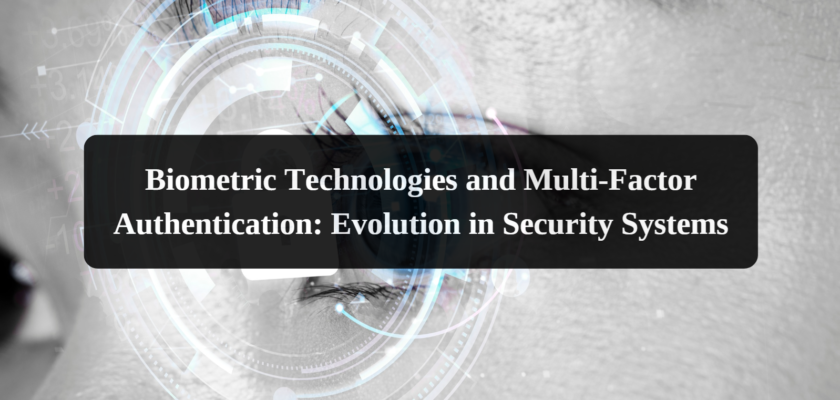Multi-factor authentication (MFA) is a technique in information security that verifies the identity of a user by having the user issue various independent credentials required in the process of gaining access to a system. Traditional methods require the user to remember (e.g. password), possess (e.g. security token) or use (biometric verification). Nevertheless, traditional MFA systems, whilst effective in enhancing security, are still susceptible to a lot of other forms of cyber-attacks, including phishing, token theft, and brute force attacks.
The Importance of Behavioral Biometrics in Furthering the Development of Security
Behavioral biometrics provide a further level of dynamic security through the recognition of the way an individual types and even moves a mouse if using a PC, or walking patterns if using mobile devices. This approach gives the continuous kind of authentication; it does not happen only at the point of login but rather through a session of the user, making it way much harder for unauthorized access.
The purpose of this paper: to explore the use of behavioural biometrics in MFA systems to mitigate cyber-physical threats. The discussion will focus on possible improvements needed to make authentication systems more resilient to sophisticated cyber attacks and reduce security risk to a significant level.
Fundamental Principles of Behavioral Biometrics and Their Advantages

Behavioral biometric will identify a person’s mannerism that relates to distinct patterns in human activity and marks a very important revolution in the technology of authentication. This section examines its types, data collection technologies, and massive security enhancement the method provides.
Definition and Types of Behavioral Biometrics
Behavioral biometrics is, in fact, a sub-discipline of biometric recognition technology, and it regards itself to the identification of persons in the basis of their behavior pattern. While physical biometric takes into account one’s intrinsic characteristics, for instance, his or her fingerprints or the pattern of his or her iris, behavioral biometric takes into account dynamic activities in which that person is involved. It includes:
- Key Press Dynamics: refers to the timing and force applied by the user while typing on the keyboard. The algorithm further analyzes the time difference in dwell time and the flight time.
- Mouse Movement Analysis: This is the tracing of how a user moves a mouse or navigates a pointer on the screen. Monitored data points shall include speed, trajectory, and pattern of clicking.
- Voice pattern identification: This method will extract useful information from the user’s voice about speech content and voice characteristics such as pitch, timbre and voice rhythm.
These are specific data points collected by sensors or software in devices, analyzed by advanced algorithms in the continuous verification of identity.
Technologies for Data Collection and Analysis
Behavioral biometrics data is collected with the help of special software that carries out its activity in the background of the device. This software is developed for monitoring user activity and automatically records the behavioral pattern. The core uses two algorithms in these systems:
- Pattern recognition algorithms: This type of algorithm is designed so that it learns both the various patterns of user behavior and recognizes them. Such algorithms, over time, adapt and detect changes in behavior and thus make sure to keep the created biometric profile accurate.
- Anomaly detection algorithms: Primarily used for security purposes; these algorithms analyse patterns of behaviour and any actions that may fall outside of the normative conditions. This may signal fraud or an unauthorised access attempt.
These technologies are injected into authentication systems to better security but further assure that the process of monitoring is streamlined and does not in any way violate user experience.
Impact on User Experience
Embedded behavioral biometrics increases user friendliness in that it allows for continuous authentication with minimal interruption in the daily routine of the user. Such technologies come with the benefit of users avoiding either the intricacies of multi-password remembrance or having always to carry physical authentication devices with them to access a service. Therefore, besides it being a tool for enhanced security, behavioral biometrics will make an approach to technology more “human.”
Comparison of Behavioral Biometrics to Traditional Authentication Methods
Behavioral biometrics offer several benefits when contrasted with traditional methods for authenticating users, such as tokens and passwords. This merits great significance to practical applications of the behavioral approach’s superiority to ensure improved accuracy and security in identification.
Effectiveness in User Identification
Traditional authentication technologies such as passwords and tokens form the backbone of modern security, but they are open to numerous vulnerabilities. Passwords can prey on various attacks, such as phishing and brute-force attempts. Tokens can be physically lost or stolen; both can be copied or bypassed without immediate detection. On the other hand, behavioral biometrics increases security to a new level by quickly detecting suspicious user activity and initiating the next level of checks to perform verification.
Cyber-Physical Threats: How Behavioral Biometrics Mitigates these Risks
The threats can be classified as cyber-physical risks that involve both the digital and physical threats. These threats are particularly pertinent in environments where technology interfaces directly with the physical infrastructure, like industrial control systems, healthcare facilities, and utility networks. The consequences can be severe, potentially leading to disruptions of services, safety hazards, or even catastrophic failures when digital security breaches translate into physical outcomes.
Cyber-Physical Attack Scenarios
In scenarios such as an attack on the power grid, attackers can hack into control systems and alter the operation of the power grid, resulting in power outages or equipment damage. In healthcare, hackers can gain control of medical devices connected to the network and alter their functionality, directly jeopardising the health of patients.
Mitigating Risks with Behavioral Biometrics
Behavioral biometrics enhances the security of systems vulnerable to cyber-physical attacks by enabling continuous authentication. This technology consistently monitors user behavior to detect anomalies that could indicate unauthorized or malicious activities.
- Real-Time Monitoring and Reaction: Behavioral biometrics systems operate in real-time, continuously tracking user activities to identify any anomalies that may suggest unauthorized access or potential malicious actions. For instance, the system might send alerts due to anomalies in the operation of control systems or detect unexpected access to sensitive areas within a network.
- Automated Security Protocols: Upon detecting suspicious behavior, behavioral biometrics systems can automatically initiate security protocols. This could include locking down affected systems, requiring additional authentication, or alerting security personnel to potential threats. These automated responses are crucial in preventing attackers from causing physical damage.
Strategies for Enhancing Security
Integrating behavioral biometrics with other security measures can provide a robust defense against cyber-physical threats. For example:
- Layered Security Approaches: Combining behavioral biometrics with traditional security measures such as encryption, firewalls, and physical security controls creates a multi-layered defense strategy that addresses both cyber and physical vulnerabilities.
- Continuous Improvement and Adaptation: Security systems incorporating behavioral biometrics should continuously evolve based on new threats and technological advancements. Regular updates and adaptations to the biometric algorithms ensure that the security measures remain effective against sophisticated attacks.
Organizations that effectively integrate behavioral biometrics into their security frameworks are likely to have stronger resilience against cyber-physical threats, ensuring that both their digital and physical assets are well-protected.
Challenges and obstacles in the implementation of behavioral biometrics:
However, deploying behavioral biometrics is filled with numerous barriers, from privacy and data protection concerns to the complexity of technical and organizational issues. This segment discusses these hurdles and underscores the need for careful implementation strategies.
Privacy Concerns and Data Protection
Among the central risks related to deploying behavioral biometrics is the need to ensure privacy and data protection, as such technologies necessarily involve access to very sensitive personal data concerning behavior. It is crucial that this data is handled securely and complies with established privacy laws, such as the GDPR in Europe or CCPA in California. Users should be informed about the type of information collected, how that information will be used, and who will have access to it. They must have control over their own information.
Technical and Organizational Complexities
Integrating behavioral biometrics into legacy security systems presents a technical challenge. Such systems require cutting-edge technology and highly skilled personnel not only at the stage of implementation but also throughout the maintenance process. Organizations also strive to balance these requirements to ensure a necessary level of security without creating an inconvenient or cumbersome user experience, which could result in user dissatisfaction or reduced productivity.
Potential Ethical and Legal Issues
The use of behavioral biometrics carries potential legal challenges, particularly regarding user consent and the risk of unwanted discrimination. Ethical issues may arise when considering scenarios where behavioural data is used not only for security purposes, but also for purposes such as employee monitoring or targeted advertising. It is important to consider all of these issues to ensure that the use of behavioural biometrics is legitimate and ethical.
The Future of Behavioral Biometrics in Multi-Factor Authentication Systems
Bright future of behavioral biometrics in multi-factor authentication is there, driven both by technology advancement and by the ever-growing need to have secure, user-convenient authentication solutions.
Trends and Ongoing Research
Area of behavioral biometrics is evolving very fast because current and continued research focuses on improved accuracy, along with reducing false positives. The real big difference today is that key innovations are being driven by machine learning and artificial intelligence. There is continuous research going on, looking for the development of such algorithms that would more accurately analyze and interpret even complicated behavioral patterns, and thus improve system security and user friendliness.
Opportunities for System Enhancement
Behavioural biometrics technology continues to evolve, so it can be integrated with other biometric and encryption technologies to create a robust multimodal security system. Any such enhancement is likely to increase the effectiveness of these systems as well as their acceptability to users.
Predictions for Widespread Adoption
In the future, more and more companies will implement behavioural biometrics as part of two-factor authentication. This will be a new wave driven by the need for stronger defences that are easy to use. The first to go for it will be those industries with a greater need for security: banking, healthcare or government. This means that if more people trust biometric behavioural technologies, we are likely to see them more often in everyday life.
Conclusion
Such technologies improve security not only by adapting to user behavioural patterns, but also by providing continuous authentication without compromising usability. It is important to recognise that, despite the benefits, there are significant challenges, including privacy issues and implementation complexity. However, further research and technology development promises to improve the accuracy and efficiency of such systems. In summary, behavioural biometric technologies are an actively developing area that may represent a very promising direction for future security in many areas.

